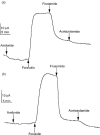Formal analysis of electrogenic sodium, potassium, chloride and bicarbonate transport in mouse colon epithelium
- PMID: 10051156
- PMCID: PMC1565794
- DOI: 10.1038/sj.bjp.0702290
Formal analysis of electrogenic sodium, potassium, chloride and bicarbonate transport in mouse colon epithelium
Abstract
1. The mammalian colonic epithelium carries out a number of different transporting activities simultaneously, of which more than one is increased following activation with a single agonist. These separate activities can be quantified by solving a set of equations describing these activities, provided some of the dependent variables can be eliminated. Using variations in the experimental conditions, blocking drugs and comparing wild type tissues with those from transgenic animals this has been achieved for electrogenic ion transporting activity of the mouse colon. 2. Basal activity and that following activation with forskolin was measured by short circuit current in isolated mouse colonic epithelia from normal and cystic fibrosis (CF) mice. 3. Using amiloride it is shown that CF colons show increased electrogenic sodium absorption compared to wild type tissues. CF mice had elevated plasma aldosterone, which may be responsible for part or all of the increased sodium absorbtion in CF colons. 4. The derived values for electrogenic chloride secretion and for electrogenic potassium secretion were increased by 13 and 3 fold respectively by forskolin, compared to basal state values for these processes. 5. The loop diuretic, frusemide, completely inhibited electrogenic potassium secretion, but apparently only partially inhibited electrogenic chloride secretion. However, use of bicarbonate-free solutions and acetazolamide reduced the frusemide-resistant current, suggesting that electrogenic bicarbonate secretion accounts for the frusemide-resistant current. 6. It is argued that the use of tissues from transgenic animals is an important adjunct to pharmacological analysis, especially where effects in tissues result in the activation of more than one sort of response.
Figures





Similar articles
-
Ion-transporting activity in the murine colonic epithelium of normal animals and animals with cystic fibrosis.Pflugers Arch. 1994 Oct;428(5-6):508-15. doi: 10.1007/BF00374572. Pflugers Arch. 1994. PMID: 7838673
-
Importance of basolateral K+ conductance in maintaining Cl- secretion in murine nasal and colonic epithelia.J Physiol. 1998 Jul 1;510 ( Pt 1)(Pt 1):237-47. doi: 10.1111/j.1469-7793.1998.237bz.x. J Physiol. 1998. PMID: 9625880 Free PMC article.
-
Inhibition of amiloride-sensitive Na(+) absorption by activation of CFTR in mouse endometrial epithelium.Pflugers Arch. 2001;443 Suppl 1:S132-6. doi: 10.1007/s004240100660. Epub 2001 Jul 10. Pflugers Arch. 2001. PMID: 11845319
-
Chloride transport by high-resistance heterocellular epithelia.Physiol Rev. 1991 Jan;71(1):235-83. doi: 10.1152/physrev.1991.71.1.235. Physiol Rev. 1991. PMID: 1986389 Review. No abstract available.
-
Diversity of kinin effects on transporting epithelia.Adv Exp Med Biol. 1989;247A:105-11. doi: 10.1007/978-1-4615-9543-4_15. Adv Exp Med Biol. 1989. PMID: 2690584 Review. No abstract available.
Cited by
-
Status of fluid and electrolyte absorption in cystic fibrosis.Cold Spring Harb Perspect Med. 2013 Jan 1;3(1):a009555. doi: 10.1101/cshperspect.a009555. Cold Spring Harb Perspect Med. 2013. PMID: 23284077 Free PMC article.
-
A comparison of linaclotide and lubiprostone dosing regimens on ion transport responses in human colonic mucosa.Pharmacol Res Perspect. 2015 Mar;3(2):e00128. doi: 10.1002/prp2.128. Epub 2015 Mar 13. Pharmacol Res Perspect. 2015. PMID: 26038704 Free PMC article.
-
Keratins modulate colonocyte electrolyte transport via protein mistargeting.J Cell Biol. 2004 Mar 15;164(6):911-21. doi: 10.1083/jcb.200308103. Epub 2004 Mar 8. J Cell Biol. 2004. PMID: 15007064 Free PMC article.
-
Activation of AMPK inhibits cholera toxin stimulated chloride secretion in human and murine intestine.PLoS One. 2013 Jul 30;8(7):e69050. doi: 10.1371/journal.pone.0069050. Print 2013. PLoS One. 2013. PMID: 23935921 Free PMC article.
-
Distension evoked mucosal secretion in human and porcine colon in vitro.PLoS One. 2023 Apr 13;18(4):e0282732. doi: 10.1371/journal.pone.0282732. eCollection 2023. PLoS One. 2023. PMID: 37053302 Free PMC article.
References
-
- COLLEDGE W.H., ABELLA B.S., SOUTHERN K.W., RATCLIFF R., JIANG C., CHENG S.H., MacVINISH L.J., ANDERSON J.R., CUTHBERT A.W., EVANS M.J. Generation and characterisation of a ΔF508 cystic fibrosis mouse model. Nature Genet. 1995;10:445–452. - PubMed
-
- CUTHBERT A.W., MacVINISH L.J., HICKMAN M.E., RATCLIFF R., COLLEDGE W.H., EVANS M.J. Ion-transporting activity in the murine colonic epithelium of normal animals and animals with cystic fibrosis. Pflugers Arch. 1994;428:508–515. - PubMed
Publication types
MeSH terms
Substances
LinkOut - more resources
Full Text Sources

